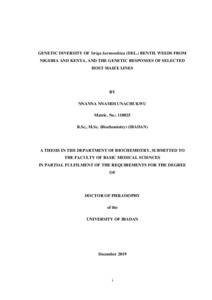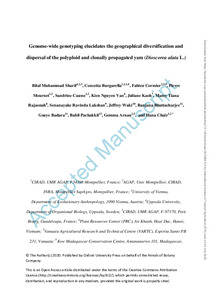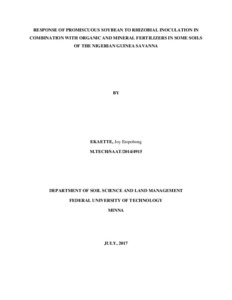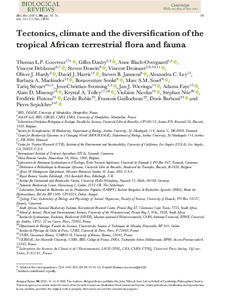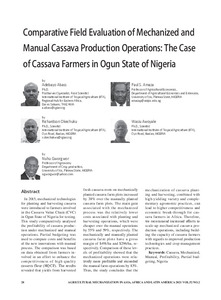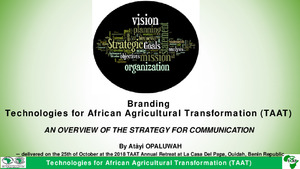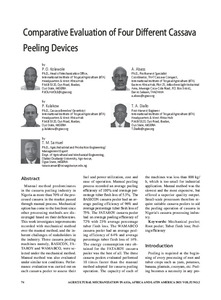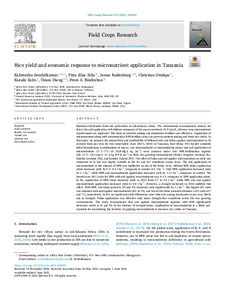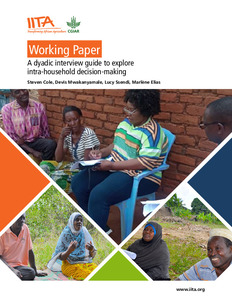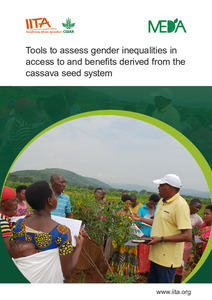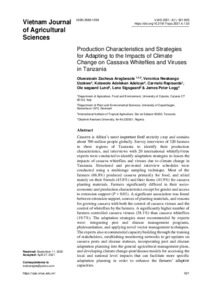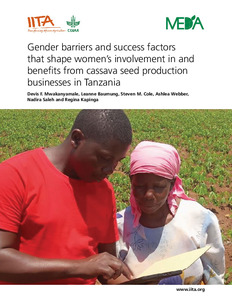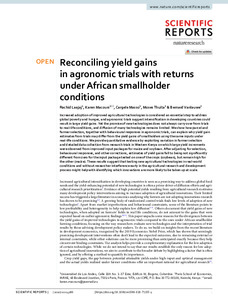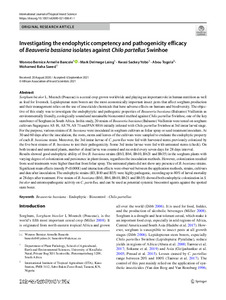Welcome to the International Institute of Tropical Agriculture Research Repository
IITA Bibliography System: Recent submissions
Now showing items 1181-1200 of 7933
-
The role of variety attributes in the uptake of new hybrid bananas among smallholder rural farmers in central Uganda
(2020)Background While advances in agricultural research and development have led to generation of improved new cooking hybrid banana varieties (HBVs) with enhanced yield potential to restore production levels, these have been received with mixed feelings on production and consumption attributes among the farming communities in Uganda. Some farmers prefer HBVs that are comparable to their local varieties in terms of consumption attributes such as soft food, color when cooked, flavor and taste while ... -
Genetic diversity of Striga hermonthica (Del.) benth. weeds from Nigeria and Kenya, and the genetic responses of selected hist maize lines
(University of Ibadan, 2019-12)Striga hermonthica (SH) is a parasitic weed that attacks and significantly reduces the yield of maize in Africa. The genetic interactions responsible for resistance or susceptibility of hosts to the parasite and the genetic differentiation that exists between and within SH populations are not fully known. This study investigated the genetic diversity of SH populations in the largest maize producers in Sub-Saharan Africa (Kenya and Nigeria) and; the genetic responses of a susceptible (5057) and a ... -
Mitigating Striga hermonthica parasitism and damage in maize using soybean rotation, nitrogen application, and Striga-resistant varieties in the Nigerian savannas
(2020-08)Striga hermonthica infestation causes significant losses of maize yield in the Nigerian savannas and several technologies have been developed and promoted to control Striga in maize. However, since no single technology has been found to be effective against Striga, integrated management is needed to achieve satisfactory and sustainable Striga control. Both on-station and on-farm trials were undertaken from 2013 to 2015 in Bauchi and Kano States of Nigeria to evaluate the performance of integrated ... -
Genome-wide genotyping elucidates the geographical diversification and dispersal of the polyploid and clonally propagated yam (Dioscorea alata L.)
(2020-11-02)Background and Aims Inferring the diffusion history of many human-dispersed species is still not straightforward due to unresolved past human migrations. The centre of diversification and routes of migration of the autopolyploid and clonally propagated greater yam, Dioscorea alata, one of the oldest edible tubers, remain unclear. Here, we address yam demographic and dispersal history using a worldwide sample. Methods We characterized genome-wide patterns of genetic variation using genotyping by ... -
Response of promiscuous soybean to rhizobial inoculation in combination with organic and mineral fertilizers in some soils of the Nigeria Guinea Savanna
(Federal University of Technology, Minna, 2017)Effective soybean rhizobia are seldom found in sufficient or large numbers in the soils that have no history of soybean cultivation. There may be a need for soybean grown in such soils to be supplied with inoculant rhizobia to ensure optimal inputs from biological nitrogen fixation. Reports have indicated that yield per hectare of soybean in farmers’ fields are still very low. This scenario calls for trials that are capable of establishing some of the biophysical factors limiting the yield of ... -
Tectonics, climate and the diversification of the tropical African terrestrial flora and fauna
(2021)Tropical Africa is home to an astonishing biodiversity occurring in a variety of ecosystems. Past climatic change and geological events have impacted the evolution and diversification of this biodiversity. During the last two decades, around 90 dated molecular phylogenies of different clades across animals and plants have been published leading to an increased understanding of the diversification and speciation processes generating tropical African biodiversity. In parallel, extended geological ... -
Comparative field evaluation of mechanized and manual cassava production operations: the case of cassava farmers in Ogun state of Nigeria
(2021)In 2015, mechanized technologies for planting and harvesting cassava were introduced to farmers involved in the Cassava Value Chain (CVC) in Ogun State of Nigeria for testing. This study comparatively analysed the profitability of cassava production under mechanized and manual operations. Partial budgeting was used to compare costs and benefits of the new innovations with manual process. The comparison was based on data obtained from farmers involved in an effort to enhance the competitiveness of ... -
Branding Technologies for African Agricultural Transformation (TAAT): an overview of the strategy for communication
(Technologies for African Agricultural Transformation, 2018) -
Beyond survival opportunities: enhancing youth livelihoods within the rural space through informed policies in Nigeria
(International Institute of Tropical Agriculture, 2021) -
Developing high-yielding Striga-resistant maize in sub-Saharan Africa
(2021)Striga hermonthica is a major stress of maize in sub-Saharan Africa (SSA). The International Institute of Tropical Agriculture (IITA), in collaboration with national scientists, have used team approach to investigate how best to solve the problem. Emphasis was on (i) establishing a reliable infestation technique for selecting resistant/tolerant genotypes, (ii) availability of appropriate germplasm and good sources of Striga resistance, (iii) use of appropriate breeding methods for incorporating ... -
Comparative evaluation of four different cassava peeling devices
(2021)Manual method predominates in the cassava peeling industry in Nigeria as more than 70% of the processed cassava in the market passed through manual process. Mechanical option has come to the forefront since other processing methods are discouraged based on their deficiencies. This work investigates improvements recorded with mechanical method over the manual method, and the inherent challenges of stakeholders in the industry. Three cassava peeling machines namely, BASICON, FATAROY and WAMABCO, ... -
Rice yield and economic response to micronutrient application in Tanzania
(2021-08-01)Nutrient deficiencies limit rice production in sub-Saharan Africa. The conventional recommended remedy for this is the soil application of fertilizers composed of the macro-nutrients, N, P and K, whereas crop micronutrient requirements are neglected. This leads to nutrient mining and diminished fertiliser use efficiency. Application of micronutrients along with recommended NPK fertiliser rates can prevent nutrient mining and boost rice yields. In this study, we assessed the productivity and ... -
A dyadic interview guide to explore intra-household decision-making
(International Institute of Tropical Agriculture, 2021-12)Studies in the agricultural research for development literature that explore women’s involvement in decision-making within the household tend to focus their analysis on married or cohabiting couples and often consult only one spouse in a marital dyad during field interviews. These and other studies in the literature explore who makes a particular decision within the household, and more recently, inquire about the extent to which the respondent or another household member was involved in the ... -
Expansion of the cassava brown streak disease epidemic in eastern Democratic Republic of Congo
(2021-08)Cassava plays a key role in ensuring food security and generating income for smallholder farmers throughout Central Africa, particularly in the Democratic Republic of Congo (DRC). This status is threatened, however, by cassava brown streak disease (CBSD), which has expanded its incidence and range in eastern DRC. The study described here comprises the first extensive assessment of temporal change in the occurrence of CBSD and its causal viruses in DRC, based on surveys conducted during 2016 and ... -
Tools to assess gender inequalities in access to and benefits derived from the cassava seed system
(International Institute of Tropical Agriculture, 2021) -
Production characteristics and strategies for adapting to the impacts of climate change on cassava whiteflies and viruses in Tanzania
(2021)Cassava is Africa’s most important food security crop and sustains about 700 million people globally. Survey interviews of 320 farmers in three regions of Tanzania to identify their production characteristics, and interviews with 20 international whitefly/virus experts were conductedto identify adaptation strategies to lessen the impacts of cassava whiteflies and viruses due to climate change in Tanzania. Structured and pre-tested interview schedules were conducted using a multistage sampling ... -
Storage root yield response to leaf harvest of improved and local cassava varieties in DR Congo
(2021)Although cassava is usually grown for its starchy roots, cassava leaves are an important vegetable and protein source in sub-Saharan countries. Eleven cassava mosaic disease (CMD) tolerant and two susceptible varieties were planted in six trials; leaves were harvested at 4, 8 and 11 months after planting (MAP) and storage roots were harvested at 12 MAP. Edible leaf and storage root dry matter yields were strongly affected by variety and interacted with location. Edible leaf yields ranged from 209 ... -
Gender barriers and success factors that shape women's involvement in and benefits from cassava seed production businesses in Tanzania
(International Institute of Tropical Agriculture, 2021-09) -
Reconciling yield gains in agronomic trials with returns under African smallholder conditions
(2020)Increased adoption of improved agricultural technologies is considered an essential step to address global poverty and hunger, and agronomic trials suggest intensification in developing countries could result in large yield gains. Yet the promise of new technologies does not always carry over from trials to real-life conditions, and diffusion of many technologies remains limited. We show how parcel and farmer selection, together with behavioural responses in agronomic trials, can explain why yield ... -
Investigating the endophytic competency and pathogenicity efficacy of Beauveria bassiana isolates against Chilo partellus Swinhoe
(2021)Sorghum bicolor L. Moench (Poaceae) is a cereal crop grown worldwide and playing an important role in human nutrition as well as feed for livestock. Lepidopteran stem borers are the most economically important insect pests that affect sorghum production and their management relies on the use of insecticide chemicals that have adverse effects on humans and biodiversity. The objective of this study was to investigate the endophytytic and pathogenic properties of Beauveria bassiana (Balsamo) Vuillemin ...


